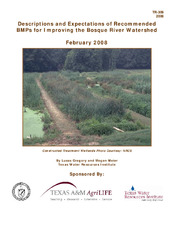| dc.description.abstract | The Bosque River and its watershed face complex water quality problems that are not easy to solve. Attempts have been made to improve the quality of the water moving through this watershed, but have had little success due to the broad scope of work that is needed to positively impact water quality in the Bosque River. This document is part of a multi-faceted project that aims to improve the environmental infrastructure in the watershed in a manner that focuses on existing pollution issues. The project’s first phase, which included the development of an environmental infrastructure improvement plan, has been completed. This plan outlined a methodology for determining likely areas that would contribute the most significant source of pollution to the watershed and developed a tool for determining the priority in which all sub-watersheds in the basins should be evaluated for needed pollution abatement measures. The Phase I report also established a list of feasible best management practices (BMPs) and ranked them based on the recommendations of a scientific advisory committee. Six steps were identified as an effective process to choose the proper BMPs for each sub-watershed in the basin. If these steps are followed, the best BMPs for each location should be effectively identified.
This document expands on the Phase I report by providing an in-depth physical description of each BMP along with an overview of potential costs and applicable areas, situations, and locations where these practices should be implemented. The BMPs are organized into five groups based on applicable location(s): on-farm BMPs, between field and creek BMPs, in-stream or gully BMPs, universal BMPs, and city BMPs. The majority of these BMPs target the excessive amount of nutrients, especially phosphorus (P), entering surface water supplies. Several BMPs also focus on sediment control, as some of the soils in the watershed are highly erosive and pose the threat of transporting nutrients with them when they erode. Some BMPs also address ecosystem health and habitat issues in the watershed. Collectively, the recommended BMPs aim to improve the overall quality and productivity of the entire watershed.
Many of these BMPs involve simple, inexpensive adjustments of current practices while others require more significant changes that may require technical and financial assistance. The last section of this document highlights potential sources of technical information and methods for disseminating educational materials to landowners and other interested parties. Potential federal and state sources of funding are also listed in this section for the use of parties considering the installation of multiple or more expensive BMPs on their land.
This document serves as a source of general information about BMPs that would benefit landowners and agency personnel assisting landowners in the Bosque River watershed. This information can help guide interested parties to BMPs that are most feasible for their needs as well as provide a general overview of how to implement the selected practice(s) to yield the best results for their location. Successful BMP implementation will reduce the impact of human activities and lead to environmental improvement in the Bosque watershed. | en |


